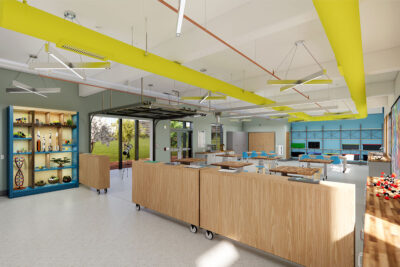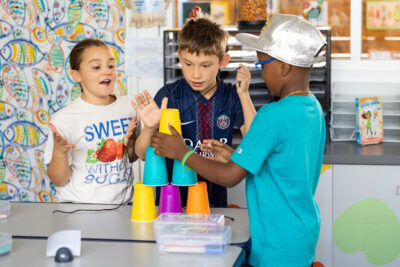“The Da Vinci Lab will give students an opportunity to go somewhere and just wonder and be curious,” shares Oakwood Elementary School Principal Denise Ross. “And then teach them how to ask questions, how to take notes, how to carry that curiosity forward into imagination and invention.”
The Da Vinci Lab and Classroom Complex will open at the elementary campus in January 2026. Designed as a space for student-centered, hands-on experiences, this new space will spark curiosity, cultivate problem-solving, and fuel innovation. Students will inquire, explore, and make discoveries about topics with personal and real-life relevance
Describing her vision for teaching and learning, Denise uses the metaphor of weaving together head, hand, eye, and heart to nurture the whole child. The head represents brainstorming, acquiring knowledge, wondering, and critical thinking. The hand signifies inventing, creating, and building. The eye captures the ability to envision, imagine, and design through the arts. Lastly, the heart reflects developing passion, empathy, social, and emotional engagement.
“The goals of the Da Vinci Lab mirror so much of what is written in Oakwood’s Statement of Philosophy. It’s such a good way to live our mission.” – Denise Ross
She also shares that the Da Vinci Lab curriculum is organized into three phases of learning, each with an increasing level of complexity: Learning emerges through curiosity, observation, and questions. Learning evolves through imagination, creativity, exploration, and problem-solving. Learning endures through purpose, invention, implementation, and action. These phases will not be mutually exclusive; students at all grade levels will engage with each phase as they build knowledge and confidence.
While these structures provide a foundation, Denise emphasizes that the Da Vinci Lab curriculum is a “living, iterative document.” It is designed to grow and adapt over time, evolving with students, their questions, and the world around them.
Instructional approaches will include Design Thinking, Project- and Inquiry-based learning, STEAM, Makerspace, woodworking, and open-ended explorations. To help structure this open-ended work, students will be introduced to provocations: questions, images, or videos that spark inquiry. “It could be something like, how would you alleviate traffic on the freeway?” Denise explains. “Everyone gets the same prompt, but each child approaches it in a completely different way. There’s no single right answer; it’s about exploring ideas and possibilities.”
This process will also come to life in projects like one led by Oakwood’s Technology Instructor and Explorations Coordinator, Shane Finch, whose sustainability unit challenges first graders to invent creative ways to clean up garbage in the ocean. “He does a ‘Shark Tank’ activity with them. They draw their invention and then present it to judges. Their machines are enormous contraptions scooping trash from the sea, and their creativity is amazing,” Denise adds.
After the Da Vinci Lab opens, projects like these will go even further. Students might refine their drawings, build prototypes, or use a 3D printer to bring their ideas to life. From wonder to imagination to invention, the process will mirror Da Vinci’s own relentless curiosity and pursuit of knowledge.
“The goals of the Da Vinci Lab mirror so much of what is written in Oakwood’s Statement of Philosophy,” Denise notes. “It’s such a good way to live our mission.”
As she reflects on this milestone, Denise shares her personal hopes: “There’s excitement and anticipation. This has been a dream for a long time, and I want it to succeed and do all the things that we were hoping it would be for the children.”



